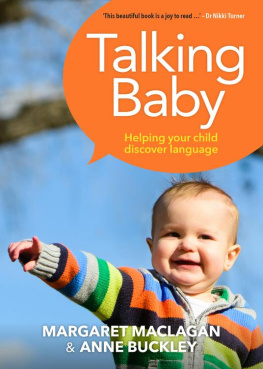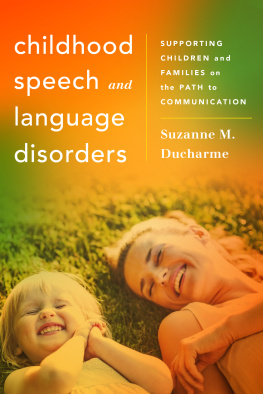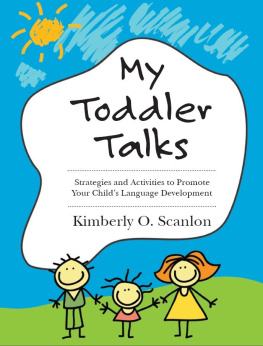Thank you for downloading this AMACOM eBook.
Sign up for our newsletter, AMACOM BookAlert, and receive special offers, access to free samples, and info on the latest new releases from AMACOM, the book publishing division of American Management Association.
To sign up, visit our website: www.amacombooks.org

ADVANCE PRAISE FOR TIME TO TALK
Time to Talk is a phenomenally valuable and highly readable guide to your childs speech and language development. I wish this book had been available when my children were babies. Dr. Michelle and Carlyn have distilled a vast academic literature down into a single volume full of clear explanations, illustrative stories, and practical tips that will be helpful to all parents who want to enrich their childrens learning environments. Parents of children with delays or other special needs will find the authors clear and honest introduction to speech and language services to be especially useful.
Margo Gardner, Ph.D., Senior Research Scientist, National Center for Children and Families, Teachers College, Columbia University
From tips to takeaways to red flags to Q&As, Dr. Michelle has created an in-depth treasure book of priceless information that can be easily digested by busy parents and education professionals.
Sarita Austin, Ph.D., CCC-SLP, TSHH, Cert HCPC, MRCSLT, Director, Department of Speech-Language Pathology, New York Center for Child Development, Founder and Artistic Director www.pureflowtheatreworks.com
While giving a lucid and clear introduction to the building blocks of speech and language including hearing, where this book really shines is in making clear the milestones that should be reached in a child with normally developing speech and language. If an evaluation or therapy is necessary, this knowledge will prevent any delays that could adversely affect the child. A remarkable feat.
Ari J Goldsmith, MD, FAAP, Pediatric Otolaryngology (Ear, Nose and Throat), Maimonides Pediatric Otolaryngology, Brooklyn, New York
Time to Talk
Time to Talk
What You Need to Know About Your Childs
Speech and Language Development
MICHELLE MACROY-HIGGINS Ph.D.
CARLYN KOLKER

ACKNOWLEDGMENTS
Thank you to so many friends, colleagues, and family members who helped us create Time to Talk.
An enormous thank-you to all the families who have shared their stories with us, especially those we interviewed for our A Parents Perspective feature. Everything we learned from you is a part of this book.
A few people deserve a special shout-out:
Thank you to Dr. Michael Higgins, who was all ears throughout the entire process of writing this manuscript, and especially for his contributions to .
Dr. Nancy Eng shared her expertise in multilingualism both as a professional and as a parent.
Meg Moorhouse helped us realize Time to Talk from a sloppy few scraps of paper to a truly professional act.
Abigail Koons believed in our vision and stuck with us. Thank you to Abby and everyone at Park Literary for your help, patience, and guidance.
We were so extremely lucky to work with Bob Nirkind, a gifted, swift, and exacting editor who was always a joy to collaborate and correspond with.
Aimee Sicuro gave us the best drawing of an ear a human could make.
Thank you to those who read, commented on, and provided advice on our proposal and manuscript, including Natalie Buzzeo, Paul Cascella, Helen Coster, Kevin Dalton, Dana Dillon, Elizabeth Galletta, Elizabeth Gradinger, Gabrielle Kahn, Abigail Marcus, Antonia Schroeder, Craig Selinger, Amy Singer, Sara Weiss, and Lauren Zierer.
Research related to this manuscript was supported by Hunter College of the City University of New York (CUNY) through PSCCUNY Grant 67710-00 45 and the Presidents Fund for Faculty Advancement.
And finally to our families, who put up with us during many nights of talking and writing and especially Annabel, Caleb, Charlotte, and Zekeour very own talkers.
CONTENTS
Time to Talk
INTRODUCTION
IN THE BOOK youre now holding in your hands, were going to look closely at how your child learns to talk. The process is sometimes magical, sometimes tedious, sometimes frustrating, sometimes hilarious, sometimes easy, and sometimes difficult.
Our goal in Time to Talk is simple: to demystify how your child learns to communicate with the world. Your childs speech and language development begins the moment she is born and yelps her first cry, and unfolds throughout her childhood. Talking is the starting point for conveying ideas, expressing needs and wants, interacting with others, and even learning to read.
The more you understand how your child begins to communicate, the more you can be there for him. When it comes to childhood development, knowledge is not just power but also empowerment: If you know how your child learns to talk, then you can help him talk more. You can help him listen better. You can help him improve his interactions with peers and teachers, friends and family. Eventually, you can help him progress from mastering the spoken word to conquering the written word. And you can be on the lookout for signs of challenges and difficulties, know when to seek help, and, if help is necessary, understand what therapy your child may need and how to get it for him.
THE ORGANIZATION AND CONTENTS
OF THIS BOOK
Speech and language development require lots of tools. These tools are physical, cognitive, social, and emotional. Some of them are innate, such as moving your mouth, and others are learned, such as grasping the meaning of a new vocabulary word. In this book, we explain how your child acquires each of these tools to create the complete set she needs.
We have organized our book to, first, familiarize you with these tools of communication: hearing, speech, language, fluency, and literacy. Then we take a deeper look at questions you may have about how your child acquires his talking tool set. The first five chapters are dedicated to providing a practical, insightful look at the essential components of listening, speaking, and reading. The sixth chapter follows up by explaining how these components come into play for children exposed to multiple languages. And finally, the last two chapters address particular concerns you may have regarding your childs speech and language development. Here, we discuss specific challenges and impairments that some children face, and we review the numerous options available to seek help for your child.
Lets get started by touching on each topic in a little more detail. focuses on hearing, because good hearing lays the fundamental groundwork for spoken language. This discussion covers everything from how hearing development happens, to the anatomy and physiology of the ear, to the types of hearing loss, and more.
In we move on to address the critical subject of speech development, the process that begins with your babys first cries and continues as your toddler babbles and your child learns to say new sounds and words. Here we look at what speech development means, how and when children acquire new sounds, and when children typically begin to achieve clarity in their speech.
new words, look at when they begin to use words to express their needs and wants, and describe how young children are simultaneously able to understand and utter language. We also investigate why some children begin to talk a little bit later than others.
Next page








